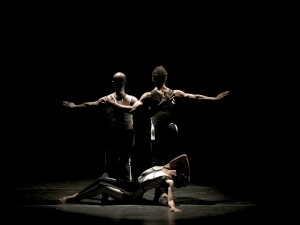Margo Lakin

Duke Dance Program Professor Ava LaVonne Vinesett is one of only 20 choreographers selected to participate in the North Carolina Dance Festival (NCDF). Traditionally a touring festival that brings modern and contemporary choreographies to audiences across the state, this year NCDF will be a virtual celebration of its 30th season.
In a “normal” year, choreographers would submit a dance for adjudication with a panel reviewing the submissions blindly and recommending finalists. From the list, NCDF staff would make curatorial choices. “We did go through the process between January and March 2020. As our plans changed, we invited the finalists to participate in the project, and we invited other choreographers as well,” explains Executive Director Anne Morris. “In extending those additional invitations, we included choreographers who had history with the NC Dance Festival, represented a variety of artistic perspectives, and were based in locations across the state.”
The choreographers selected five images from the festival’s archives to inspire a “micro dance,” a 30- to 60-second piece that was filmed and combined with the other submissions to create a film that will be presented on October 24 at 7:30pm. For more information and to register to attend, please visit the NCDF website.
Just over one minute in length, Vinesett’s “Keeping the Peace” features three North Carolina-based dancers: Ife Presswood, a Duke Dance Program MFA candidate and founder of Ife Michelle Dance in Charlotte; Tria Smothers, a Duke Dance alumna and member of the dance collective Indigo Yard Gals (founded by Vinesett and Jessica Almy-Pagán); and Oesa Savionne Vinesett, also a member of Indigo Yard Gals, as well as the Duke African Repertory Ensemble.

We were paired up with a “buddy” choreographer to select from a group of about 30 to 35 images. My partner was Carol Finley from Meredith College, and we collaborated on choosing photos that captured the physical investment of the dancers. While Carol was interested in exploring the “what happened next” aspect of the photos for her piece, I was more drawn to how the dancers actually arrived at those specific moments the images captured.
Personally, I felt the time constraint was a wink to the late Jan Van Dyke. She not only was the founder of NCDF, but also one of my professors in graduate school. I remember getting written assignments back from her with comments along the lines of “insufficient analysis.” And as a student, I’d think, “If I can say something in 16 pages, why should I need 20 pages?” In composition classes, she’d often ask me, “Ava, where is this going?” Her words really resonated with me, and she was definitely on my mind during this process.
As a choreographer, I wavered between not enough versus too much, and finding that sweet spot. Because the dance needed to stand alone within the time constraint and those five images, it forced me to stay on task. While the conceptual work understandably required much more time, the applied time of rehearsals, input and feedback from the dancers, and actual filming was much less. We had it completed by the second rehearsal.

For the audience, because the piece hasn’t aired yet, I want to be careful in leading them to a particular place. I’d hope people could watch it and identify for themselves what they pull from it; I’d encourage them to search their spirits and see what’s in there.
For myself, during this process, I couldn’t help but think about the climate of our country and acknowledge that where we are didn’t just happen. Unlike the five images each of us selected—devoid of any concrete background information—we are not living in a snapshot of some misunderstood moment of time. Acting clueless to what is obvious is unacceptable, and if you don’t know what’s going on, it’s because you don’t want to know.
Just like wearing a mask during COVID is not an option for me—being Black is also not an option. I don’t wake up and say, “Today, I choose not to be Black.” Being a Black woman, I proudly carry myself as such; I am responsible to my community—I don’t have a choice.
Click here to watch "Keeping the Peace." Sound credits: “Peace Keeping” by Omar Sosa & Seckou Keita (featuring Gustavo Ovalles) from their Transparent Water album (2017)